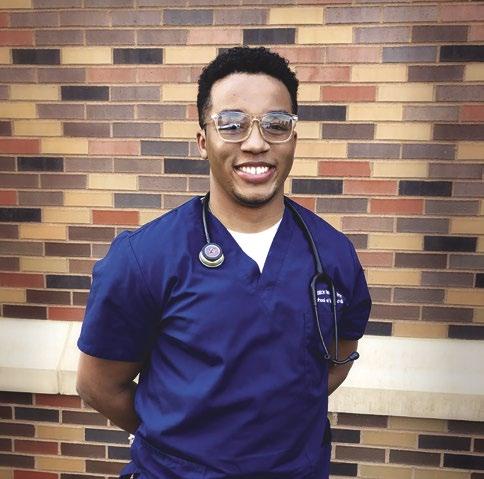
3 minute read
NURSING IN APANDEMIC
NURSING IN A PANDEMIC
Adam Hayes
Senior Nursing Major
Many have faced challenges and unique changes the past year due to the COVID-19 pandemic, but perhaps none have seen more challenges than those in the medical field. Nurses and Millikin nursing students alike have had to adapt to the current climate and have been tested to their limits.
Senior Millikin nursing student Adam Hayes noted many changes within the nursing program at Millikin. “We’ve really had to figure out a different way to study and different way to understand nursing without being in person,” Hayes said. He noted that there are unique advantages amidst the challenges of learning to be a nurse during a time where everything is online.
SUPPORT
TO SUPPORT PERFORMANCE LEARNING, VISIT
millikin.edu/millikin-fund
Being a nursing student in the time of a global pandemic has certainly not been easy, but Hayes thinks Millikin and the nursing faculty have continued to deliver Performance Learning opportunities while following state and local guidelines.
“They’ve created different outpatient opportunities,” Hayes said. “One group of students are going to an outpatient clinic and working with patients who have diabetes to see how they manage their disease, while other people are giving out vaccines during their clinical experience.”
Lizzy York Lambdin

Class of 2015
Lizzy York Lambdin, Class of 2015, has faced similar challenges in her position at Prairie Cardiovascular Consultants within HSHS St. Mary’s Hospital in Decatur, Ill.
“Nurses are built on compassion. We are built on human touch ... Having to cover our faces, constantly wearing PPE and attempting to keep a distance does not allow compassion to come easily,” she said.
When one thinks of social distancing, the physical distance comes to mind first and foremost. The emotional aspect of social distancing, especially in professions like nursing, is often overlooked.
“Nurses must be able to connect with their patients on a personal level, build good rapport with their colleagues, critically think in times of urgency and place emphasis on a multidisciplinary team approach,” Lambdin said. “Being able to offer human touch is one of the important ways to show patients that we are here both physically and emotionally.” CEO of HSHS St. Mary’s Hospital in Decatur, Ill. and 1990 Millikin graduate Theresa Rutherford has seen the challenges of COVID-19 in many aspects of the hospital setting, but has maintained that patient care is “first and foremost of [her] focus.” Rutherford can attest to the challenges throughout the hospital not only on the floor, but also from the administrative side. Rutherford commented that the biggest challenge has been “balancing the financial stability of the organization and [the] long-term service to the community and the needs of our colleagues.”
She notes that while COVID-19 is part of all hospital’s new “normal” routine, most are excited and preparing to move forward. “I’m excited for us to start growing,” she said. “The physicians in the community appreciate [that] we have all lived through COVID-19 and want to collaborate for exceptional quality, high reliability and ease of access to care for the communities we serve.”
Those working in the medical field have arguably taken the brunt of the physical and emotional havoc this pandemic has wreaked on the world. The challenges faced in the medical field during times like these are immeasurable, but those on the frontlines continue to adapt to these changes daily.

Theresa Alderman
Rutherford, Class of 1990








